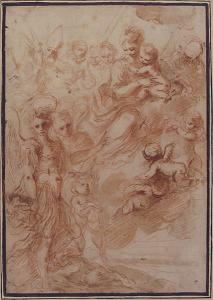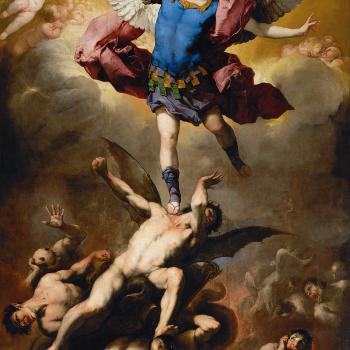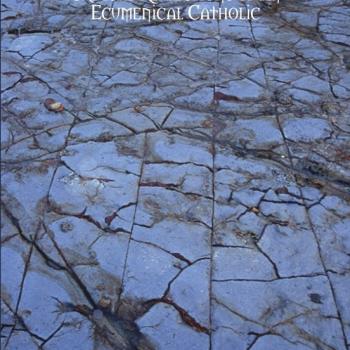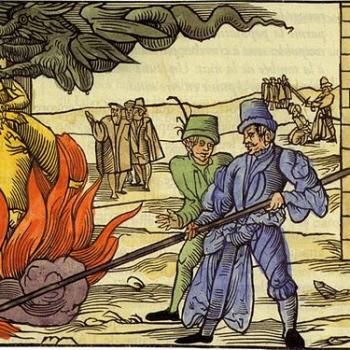16. Sheol (Hades): Merely the “Grave” or “Underground” or the Conscious Abode of Dead Souls?
Lucas Banzoli is a very active Brazilian anti-Catholic polemicist, who holds to basically a Seventh-Day Adventist theology, whereby there is no such thing as a soul that consciously exists outside of a body, and no hell (soul sleep and annihilationism). This leads him to a Christology which is deficient and heterodox in terms of Christ’s human nature after His death. He has a Master’s degree in theology, a degree and postgraduate work in history, a license in letters, and is a history teacher, author of 25 books, as well as blogmaster (but now inactive) for six blogs. He’s active on YouTube.
This is my 52nd refutation of Banzoli’s writings. From 5-25-22 until 11-12-22 (almost half a year) he didn’t write even one single word in reply. Since then he has counter-responded three times. Why so few and so late? Well, he says it’s because my articles are “without exception poor, superficial and weak . . . only a severely cognitively impaired person would be inclined to take” them “seriously.” He didn’t “waste time reading” 37 of my first 40 replies (three articles being his proof of the worthlessness of all of my 4,000+ articles and 51 books). He also denied that I had a “job” and claimed that I didn’t “work.” But he concluded that replying to me is so “entertaining” that he resolved to “make a point of rebutting” my articles “one by one.” I disposed of his relentlessly false personal insults in Facebook posts dated 11-13-22 and 11-15-22 and 11-23-22.
My current effort is a major multi-part response to Banzoli’s 1900-page self-published book, The Legend of the Immortality of the Soul [A Lenda da Imortalidade da Alma], published on 1 August 2022. He claims to have “cover[ed] in depth all the immortalist arguments” and to have “present[ed] all the biblical proofs of the death of the soul . . .” and he confidently asserted: “the immortality of the soul is at the root of almost all destructive deception and false religion.” He himself admits on page 18 of his Introduction that what he is opposing is held by “nearly all the Christians in the world.” A sincere unbiblical error (and I assume his sincerity) is no less dangerous than a deliberate lie, and we apologists will be “judged with greater strictness” for any false teachings that we spread (Jas 3:1).
I use RSV for the Bible passages (including ones that Banzoli cites) unless otherwise indicated. Google Translate is utilized to render Lucas’ Portugese into English. Occasionally I slightly modify clearly inadequate translations, so that his words will read more smoothly and meaningfully in English. His words will be in blue.
*****
See the other installments:
See also the related articles:
Seven Replies Re Interceding Saints (vs. Lucas Banzoli) [5-25-22]
Answer to Banzoli’s “Challenge” Re Intercession of Saints [9-20-22]
Bible on Praying Straight to God (vs. Lucas Banzoli) [9-21-22]
Reply to Banzoli’s “Analyzing the ‘evidence’ of saints’ intercession” [9-22-22]
*****
No wonder many immortalist apologists unfamiliar with the Hebrew text think that Solomon was speaking of the qeber (tomb) in Ecclesiastes 9:10, and not of Sheol. These changes are intentional, and are part of the subtleties with which immortalistic translators tamper with the Bible in order to obfuscate the clear truth: plain to any reader of the Hebrew, that Sheol is but the underground region of the earth. In my research to write this chapter, I discovered that Sheol appears 66 times in the Hebrew text, and that in the vast majority of them translators preferred to hide its mention, for the simple fact that the texts clearly show that it is a lifeless place where the dead are buried. In these cases, they prefer to translate it by “grave”, “tomb” or “grave”. . . . the readers unfamiliar with Hebrew are led to think that this place appears very few times in the Bible, . . . No layman can realize this when reading only translations, because the malicious translations lead to error. Instead of keeping Sheol where Sheol appears and letting the Bible interpret the Bible (i.e., that texts with less clear meaning are explained in the light of texts where the meaning is clear), they cunningly cover up Sheol in at least 80% of the texts where Sheol appears . . . immortalists take advantage of the average [Bible] reader’s ignorance. (pp. 535-536)
This is Banzoli’s infamous Vast Conspiracy of Bible Translators myth, that he spouts over and over in this ludicrously long and repetitive book (which desperately needs an editor, like I just had in my upcoming book, The Word Set in Stone: How Science, History, and Archaeology Prove Biblical Truth: Catholic Answers Press, 2023). Let’s test his theory a bit, shall we? The Revised Standard Version (RSV), published in 1952, is perhaps the most widely used Bible in English at the current time. I’ve primarily used it in my own writing for over twenty years now. I searched Sheol in the Old Testament. Banzoli says it appears 66 times there, and I’ll take his word for it. Sheol appears 65 times in the RSV Old Testament. Does that sound like a conspiracy to cover up the existence of Sheol: with a 98.5% rate of translating the Hebrew Sheol as Sheol? Was the word hidden in Ecclesiastes 9:10? No; it appears there.
I searched New American Standard Bible (NASB), published in 1971, too. It’s widely used as well (and in fact was the translation in which I read most of the Bible in the early 1980s). Evangelical Protestants especially like it. How many times does Sheol appear in the Old Testament in NASB? It appears 64 times. Does that sound like a conspiracy to cover up the existence of Sheol: with a 97% rate of translating the Hebrew Sheol as Sheol? Was the word hidden in Ecclesiastes 9:10? No; it appears there.
How about the English Standard Version (ESV), published in 2001? It’s becoming a very popular Bible, and was translated by more than 100 evangelical scholars. It already has 250 million copies in print. It has Sheol 63 times in the Old Testament, including at Ecclesiastes 9:10. Does that sound like a conspiracy to cover up the existence of Sheol: with a 95.5% rate of translating the Hebrew Sheol as Sheol?
So, as we see, the conspiracy is faring very poorly. Too many translators are dissenting from the instructions from on high, to (how did Banzoli put it?) “tamper with the Bible in order to obfuscate the clear truth”. Now let’s move on to some actually attempted arguments by Banzoli, rather than tin foil hat conspiracy theories . . . I just want to make it very clear to my readers, the sort of irrational, paranoid mentality and mindset we are dealing with, in confronting Banzoli’s massive errors. He actually believes in this demonstrably untrue conspiratorial nonsense. It’s how he rationalizes the fact that his heretical soul sleep is rejected by (as he himself concedes), “nearly all the Christians in the world.”
There are those who . . . [think] that the NT authors believed that Sheol was a place with life [conscious activity], for the simple fact that Hades, as conceived by the Greeks, was a place with life. The problem with this argument is that Hades in Greek has nothing to do with the Hades of “Christian” immortalist theology, . . . (p. 538)
This is absurd. The very fact that the New Testament authors chose to use the word Hades to translate the Hebrew Sheol, proves the conception they had of the word and place: that it was an abode of conscious souls. It’s not a perfect correation, but close enough for readers to grasp the main features of Hades. Banzoli can’t simply dismiss this highly significant fact. Jesus [Luke 16:19-31) taught that Hades contained souls who could communicate with each other, since He reported that the rich man prayed to Abraham and made requests concerning his brothers. Hades appears nine times in the New Testament in the RSV. Three of them are from Jesus. Two more instances in Acts cite a well-known OT messianic text. The remaining four are in the book of Revelation.
You will never see any of these characteristics of pagan Hades being mentioned in catechism or Sunday school, for the simple fact that the immortalists themselves are obliged to recognize that the Christian conception of Hades was far removed from of the Greek conception. Those who argue that the Christian Hades must be a place of consciousness and activity after death just because it was so in the Greek conception are forced to embrace the whole endless array of pagan and mythical figures of the Greek Hades – starting with the pagan god who designates this place. (p. 539)
If the New Testament is supposedly so opposed to Greek philosophy and indeed all pagan Greek thought whatsoever, then why did Paul cite pagan Greek poets, philosophers, and dramatists (and the Greeks started philosophy and excelled in it): Acts 17:28 (Aratus: c. 315-240 B.C., Epimenides: 6th c. B.C.), 1 Corinthians 15:33 (Menander: c.342-291 B.C.: “bad company ruins good morals”), and Titus 1:12 (Epimenides, described by Paul as a “prophet”)? In fact, the line that Paul cited on Mars Hill in Athens (Acts 17:28), from Aratus, was actually, in context, referring to Zeus:
Let us begin with Zeus, whom we mortals never leave unspoken.
For every street, every market-place is full of Zeus.
Even the sea and the harbour are full of this deity.
Everywhere everyone is indebted to Zeus.
For we are indeed his offspring… (Phaenomena 1-5)
So Paul used a pagan poet, talking about a false god (Zeus) and “Christianized” the thought, applying it to the true God. That’s Pauline apologetic method. The Church has done this, historically, by “co-opting” pagan holidays and “baptizing” them, thus eventually wiping out the old pagan holidays. The citation from Epimenides (the poem Cretica) involves the same thing; it was originally written about Zeus; Paul (Acts 17:28 again) takes it and applies it to Yahweh, the true God:
They fashioned a tomb for thee, O holy and high one—
The Cretans, always liars, evil beasts, idle bellies!
But thou art not dead: thou livest and abidest forever,
For in thee we live and move and have our being.
St. Paul expressly cites these pagan Greek poets and philosophers precisely because that is what his sophisticated Athens audience (including “Epicurean and Stoic philosophers” — 17:18) could understand and relate to. He was using wise apologetic method and strategy. This is Paul giving a concrete example of the evangelistic application of his dictum of 1 Corinthians 9:21: “To those outside the law I became as one outside the law — not being without law toward God but under the law of Christ — that I might win those outside the law.”
It’s the same with the New Testament use of Hades, to convey what the Old Testament called Sheol. It’s not a perfect match (anymore than Paul’s citations were), but close enough to serve the purpose. The primary aspects of the place are the same, but not all particulars are. The aspect of conscious souls abiding in this netherworld is central to the whole thing. It’s anything but merely a grave plot or the underground, as Banzoli imagines.
The big debate, therefore, revolves around the nature of Sheol: of which the OT speaks so much. As we will see, in the Bible Sheol/Hades invariably means the subterranean region of the earth where the dead are buried, although in texts of a poetic or allegorical nature there is freedom poetic to refer to Sheol in a figurative way (in the same sense as trees talk and talk to each other). But in immortalist theology, Sheol is the abode of the spirits of the dead, where they are conscious and suffering torment (if they are wicked) or enjoying peace and bliss (if they are righteous). (pp. 540-541)
Since Jesus taught precisely that in Luke 16, it’s a pretty biblical position to take! If it comes down to accepting the definitive teaching of our Lord and God and Savior Jesus Christ, or the contrary teaching of Lucas Banzoli, most folks know which is the wiser choice to make.
Banzoli goes on for many pages mocking the supposed belief of “immortalists” that Sheol/Hades is literally underground. Several biblical passages do refer to “under the earth” (Ex 20:4; Phil 2:10; Rev 5:3, 13) and many to “down to Sheol,” etc. But these need not be taken literally. In the Hebrew commonsense conception, mountains and the heavens represented closeness to God; hence, the contrast was Sheol or hell “down below” over against mountains and heavens. Barnes’ Notes on the Bible further elaborates:
In the great divisions here specified – of those in heaven, on the earth, and under the earth – the apostle intends, doubtless, to denote the universe. The same mode of designating the universe occurs in Revelation 5:13; Exodus 20:4; compare Psalm 96:11-12. This mode of expression is equivalent to saying, “all that is above, around, and beneath us,” and arises from what appears to us. The division is natural and obvious – that which is above us in the heavens, that which is on the earth where we dwell, and all that is beneath us.
Banzoli himself basically expresses the sense of these “directional” biblical references in another statement, commenting on verse 8 this passage:
Psalm 139:7-10 Whither shall I go from thy Spirit? Or whither shall I flee from thy presence? [8] If I ascend to heaven, thou art there! If I make my bed in Sheol, thou art there! [9] If I take the wings of the morning and dwell in the uttermost parts of the sea, [10] even there thy hand shall lead me, and thy right hand shall hold me.
[W]e see Sheol as the geographical antithesis of heaven, with the aim of reinforce that no matter how high or low the psalmist might go, he never would escape the omnipresence of God. (p. 554)
That’s much more of the sense which I believe the Bible is teaching, when referring to “under the earth” and so forth. It’s about a conceptual separation from God, not a literal “cave / caverns / journey to the center of the earth” approach to the afterlife. It helps people to conceptualize things in simple terms, according to biblical anthropomorphism.
In an article in the Catholic periodical, L’Osservatore Romano (11/18 August 1999), three talks given by Pope St. John Paul II were referred to:
In three controversial Wednesday Audiences, Pope John Paul II pointed out that the essential characteristic of heaven, hell or purgatory is that they are states of being of a spirit (angel/demon) or human soul, rather than places, as commonly perceived and represented in human language. This language of place is, according to the Pope, inadequate to describe the realities involved, since it is tied to the temporal order in which this world and we exist. In this he is applying the philosophical categories used by the Church in her theology and saying what St. Thomas Aquinas said long before him.
“Incorporeal things are not in place after a manner known and familiar to us, in which way we say that bodies are properly in place; but they are in place after a manner befitting spiritual substances, a manner that cannot be fully manifest to us.” [St. Thomas Aquinas, Summa Theologiae, Supplement, Q69, a1, reply 1]
It cites the pope’s actual words:
In the context of Revelation, we know that the “heaven” or “happiness” in which we will find ourselves is neither an abstraction nor a physical place in the clouds, but a living, personal relationship with the Holy Trinity. It is our meeting with the Father which takes place in the risen Christ through the communion of the Holy Spirit.
It is always necessary to maintain a certain restraint in describing these “ultimate realities” since their depiction is always unsatisfactory. Today, personalist language is better suited to describing the state of happiness and peace we will enjoy in our definitive communion with God. (21 July 1999)
More than a place, hell indicates the state of those who freely and definitively separate themselves from God, the source of all life and joy. (28 July 1999)
The term [purgatory] does not indicate a place, but a condition of existence. (4 August 1999)
Fr. John A. Hardon, S.J. wrote in his Catholic Catechism (Garden City, New York: Doubleday & Co., 1975):
In spite of some popular notions to the contrary, the Church has never passed judgment as to whether purgatory is a place or in a determined space where the souls are cleansed. It simply understands the expression to mean the state or condition under which the faithful departed undergo purification. (pp. 274-275)
Catholics believe the same about Sheol. Spirits do not possess dimension or spatial characteristics, so in that sense one cannot speak of “place.” In the English language (as in biblical Hebrew), “place” is sometimes used as a synonym for “condition” or “state” and perhaps this also explains some of the confusion. For example, in my Webster’s New 20th Century Dictionary (Cleveland: World Publishing Company, 1968; 2289 large pages), no less than 25 definitions of place are given, including the following:
16. (another’s) situation or state; as, you would have acted quite the same if you were in my place.
In common English, this sense is used; for example:
I came to a place in my life where I stopped worrying so much.
Or (even more poetically or metaphorically):
A loving relationship is a place where one can fully express one’s feelings and trust another.
Note that this is a use of place for an ultimately non-material entity: human relationships or love.
Thus, again, we see that this is a matter of context and language. Place in this sense can be used as interchangeable with “state” or “condition” so that there is no contradiction, rightly understood.
For mortalists, . . . the spirit is not the “real me” but just the breath of life, something impersonal that came from God (Gen 2:7) and returns to God in death (Eccl 12:7). That’s why all dead go down to Sheol, but no one goes up to the presence of God. (p. 555)
All of the dead went to Sheol before the redemptive death of Christ. After His death, Paul writes in the following terms (as I previously referred to in #12):
2 Corinthians 12:2-4 I know a man in Christ who fourteen years ago was caught up to the third heaven — whether in the body or out of the body I do not know, God knows. [3] And I know that this man was caught up into Paradise — whether in the body or out of the body I do not know, God knows — [4] and he heard things that cannot be told, which man may not utter.
What this passage shows is that Paul was in heaven. He believes it is possible to be there as a “man” either “in the body” or “out of the body.” He remains himself in either scenario. If he’s in his body, it’s him (Paul). If he is out of his body, it’s still him (Paul). The logic of this passage doesn’t permit any other interpretation. . . . Paul expresses the same notion at least two other times:
2 Corinthians 5:8 . . . we would rather be away from the body and at home with the Lord.
Philippians 1:23-24 . . . My desire is to depart and be with Christ, for that is far better. [24] But to remain in the flesh is more necessary on your account.
If Paul was nonexistent after death, since a soul supposedly can’t exist apart from a body, how could he be “home with the Lord” and “be with Christ” while “away” from his “body” and “flesh”? When he says “we” would be “away from the body and at home with the Lord” this proves that he is still referring to himself as a soul, who would be with the Lord. . . . Again he says that he would “depart and be with Christ” which is in contrast to “remain[ing] in the flesh.” This absolutely proves that he is talking about himself as a continuing conscious entity who can “be with Christ” outside of his flesh or body.
Even Job, the most righteous man of his day (Job 1:8), said that “I look for Sheol as my house” (Job 17:13), which definitively proves that Sheol is not was an exclusive abode of the wicked (like hell or whatever worth). (p. 559)
No orthodox Christian who studied Last Things (eschatology) ever said that it was only for the wicked (before Christ). Jesus makes that crystal clear n Luke 16. It would be nice if Banzoli could figure this out. But he’ll keep on spouting the contrary over and over, like every other assertion he makes in his tedious book.
It’s true that the doctrines of salvation and the eternal afterlife (both for the saved and the damned) developed quite a bit in the inter-testamental period, and then all the more so in the New Testament. But there were also many clear signs or precursors of it (some remarkably explicit) all along. The book of Job seems to allude to an eternal consciousness in a resurrected body in some sort of paradisal state with God:
Job 19:25-27 For I know that my Redeemer lives, and at last he will stand upon the earth; [26] and after my skin has been thus destroyed, then from my flesh I shall see God, [27] whom I shall see on my side, and my eyes shall behold, and not another. (cf. 14:12-15)
The prophet Isaiah (8th c. BC) taught similarly:
Isaiah 26:19a Thy dead shall live, their bodies shall rise. O dwellers in the dust, awake and sing for joy! . . .
This is hardly a shadowy temporary existence in Sheol and then annihilation. But there is much more, too:
Genesis 5:24 Enoch walked with God; and he was not, for God took him.
2 Kings 2:11 And as they still went on and talked, behold, a chariot of fire and horses of fire separated the two of them. And Eli’jah went up by a whirlwind into heaven.
Psalms 16:10-11 For thou dost not give me up to Sheol, or let thy godly one see the Pit. [11] Thou dost show me the path of life; in thy presence there is fulness of joy, in thy right hand are pleasures for evermore.
Psalms 21:4, 6 He asked life of thee; thou gavest it to him, length of days for ever and ever. . . . [6] Yea, thou dost make him most blessed for ever; thou dost make him glad with the joy of thy presence.
Psalms 23:6b . . . I shall dwell in the house of the LORD for ever.
Psalms 49:7-9, 15 Truly no man can ransom himself, or give to God the price of his life, [8] for the ransom of his life is costly, and can never suffice, [9] that he should continue to live on for ever, and never see the Pit. . . . [15] But God will ransom my soul from the power of Sheol, for he will receive me. . . .
Psalms 73:23-26 Nevertheless I am continually with thee; thou dost hold my right hand. [24] Thou dost guide me with thy counsel, and afterward thou wilt receive me to glory. [25] Whom have I in heaven but thee? And there is nothing upon earth that I desire besides thee. [26] My flesh and my heart may fail, but God is the strength of my heart and my portion for ever.
Daniel 7:18 But the saints of the Most High shall receive the kingdom, and possess the kingdom for ever, for ever and ever.
Daniel 12:1-3 “At that time shall arise Michael, the great prince who has charge of your people. And there shall be a time of trouble, such as never has been since there was a nation till that time; but at that time your people shall be delivered, every one whose name shall be found written in the book. [2] And many of those who sleep in the dust of the earth shall awake, some to everlasting life, and some to shame and everlasting contempt. [3] And those who are wise shall shine like the brightness of the firmament; and those who turn many to righteousness, like the stars for ever and ever.
The idea of being abandoned to Sheol is similar to eternal hellfire (a developmental precursor or “kernel” of it). Thus, eternal life or eschatological salvation is described as “thou dost not give me up to Sheol” (Ps 16:10). God delivers or rescues the righteous from Sheol (“he brings down to Sheol and raises up”: 1 Sam 2:6; cf. Ps 30:3; 49:15; 86:13; 89:48):
Deuteronomy 32:22a For a fire is kindled by my anger, and it burns to the depths of Sheol, . . .
Psalms 6:5 For in death there is no remembrance of thee; in Sheol who can give thee praise?
Psalms 9:17 The wicked shall depart to Sheol, all the nations that forget God.
Psalms 31:17b . . . let the wicked be put to shame, let them go dumbfounded to Sheol.
Isaiah 14:11 Your pomp is brought down to Sheol, the sound of your harps; maggots are the bed beneath you, and worms are your covering. (cf. 14:15 and Jesus’ reference to worms in hell: “where their worm does not die, and the fire is not quenched”: Mk 9:48)
Isaiah 38:18b . . . those who go down to the pit cannot hope for thy faithfulness.
Isaiah 66:24 “And they shall go forth and look on the dead bodies of the men that have rebelled against me; for their worm shall not die, their fire shall not be quenched, and they shall be an abhorrence to all flesh.”
Jeremiah 15:14b . . . in my anger a fire is kindled which shall burn for ever. (cf. 17:4)
Daniel 12:2 And many of those who sleep in the dust of the earth shall awake, some to everlasting life, and some to shame and everlasting contempt.
[see also many references to “the pit”: equivalent to Sheol]
. . . the odd separation that immortalists make between Hades for the wicked and “Abraham’s Bosom” for the righteous. (p. 586)
Remember, we know of this distinction straight from the lips of Jesus (Luke 16). So we have a scenario where Banzoli classifies the very teachings of Christ as “odd.” This reminds me of his pages and pages (that I dealt with in one of the past articles of this series), ranting against the souls under the altar in Revelation 6: blasting them as ungrateful, complaining sorts: directly contrary to what the text actually states. If Banzoli doesn’t like something clearly taught in Holy Scripture, he is not above condemning and mocking it. Needless to say, this is blasphemy.
As we have seen, according to them, Jesus promised the thief on the cross that he would be on that same day with him in Paradise (Luke 23:43), which according to Paul is in the third heaven, where God dwells (2 Co 12:2-4). However, if Jesus was in Hades after death (Acts 2:27) and if Sheol/Hades is the destination of all who die (Job 3:19; Ps 49:15, 31:17), how could the thief on the cross be in Paradise that very day? (p. 587)
I addressed this in these papers:
Multiple Meanings of “Paradise” in Scripture [1-2-14]
Did Jesus Descend to Hell, Sheol, or Paradise After His Death? [National Catholic Register, 4-17-17]
***
Practical Matters: Perhaps some of my 4,000+ free online articles (the most comprehensive “one-stop” Catholic apologetics site) or fifty books have helped you (by God’s grace) to decide to become Catholic or to return to the Church, or better understand some doctrines and why we believe them.
Or you may believe my work is worthy to support for the purpose of apologetics and evangelism in general. If so, please seriously consider a much-needed financial contribution. I’m always in need of more funds: especially monthly support. “The laborer is worthy of his wages” (1 Tim 5:18, NKJV). 1 December 2021 was my 20th anniversary as a full-time Catholic apologist, and February 2022 marked the 25th anniversary of my blog.
PayPal donations are the easiest: just send to my email address: [email protected]. You’ll see the term “Catholic Used Book Service”, which is my old side-business. To learn about the different methods of contributing, including 100% tax deduction, etc., see my page: About Catholic Apologist Dave Armstrong / Donation Information. Thanks a million from the bottom of my heart!
***
Photo credit: Saint Michael the Archangel and Another Figure Recommending a Soul to the Virgin and Child in Heaven, by Bartolomeo Biscaino (1629-1657) [public domain / Wikimedia Commons]
***
Summary: Part 16 of many responses to Lucas Banzoli’s 1900-page book, The Legend of the Immortality of the Soul: published on 1 August 2022. I defend historic Christianity.

















